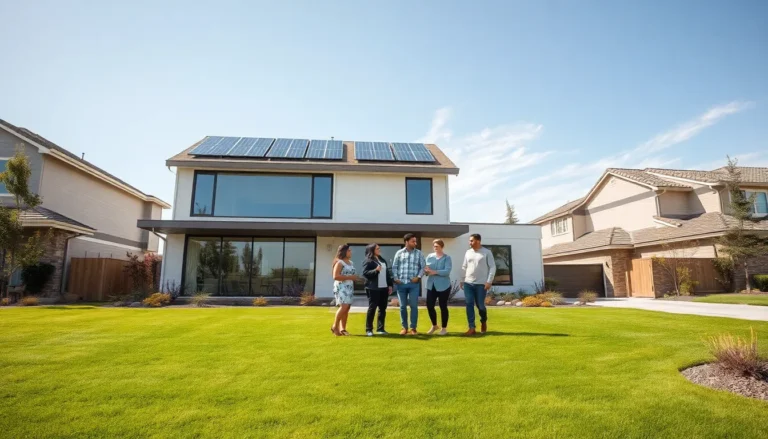Table of Contents
ToggleIn a world where energy bills can make even the most stoic homeowner weep, understanding home performance metrics isn’t just smart—it’s essential. These metrics are like the vital signs of your home, revealing how well it breathes, heats, and cools. Imagine having the power to transform your house into an energy-efficient fortress, all while saving some serious cash. Sounds like a superhero’s dream, right?
Home performance metrics help homeowners identify areas for improvement, turning energy hogs into efficient machines. Whether it’s air leaks that let your hard-earned dollars escape or appliances that guzzle energy like a thirsty marathon runner, these insights can help anyone take control of their home’s health. So buckle up and get ready to dive into the world of home performance metrics—where saving money and saving the planet go hand in hand, and maybe even with a chuckle or two.
Overview of Home Performance Metrics
Home performance metrics serve as essential indicators of a home’s efficiency and effectiveness in energy use. These metrics allow homeowners to assess heating, cooling, and overall energy consumption. Key metrics include energy use intensity (EUI), air leakage rates, and thermal comfort levels.
Energy use intensity provides insight into the total energy consumed per square foot. Understanding EUI helps homeowners compare their energy consumption to similar homes. Another vital metric is the air leakage rate, which measures how much air escapes from a home. Lower leakage rates indicate better insulation and can lead to significant cost savings.
Thermal comfort levels gauge how comfortable the indoor environment is for occupants. This metric considers factors such as temperature, humidity, and air quality. Monitoring these aspects enables homeowners to maintain a pleasant living space while improving energy efficiency.
Homeowners benefit from utilizing energy audits, which identify inefficiencies and recommend improvements. Energy audits typically involve blower door tests and thermographic inspections to pinpoint issues. Following an audit, implementing recommended changes can drastically enhance energy performance.
Before making improvements, understanding return on investment (ROI) is essential. Calculating the potential savings from energy upgrades can guide homeowners in prioritizing projects that offer the best financial return. Tracking these metrics over time allows for ongoing assessment of home performance.
Monitoring home performance metrics promotes informed decisions and sustainability. These indicators empower homeowners to create more efficient living spaces and contribute positively to the environment. Embracing home performance metrics leads to a healthier home and reduced energy costs.
Importance of Home Performance Metrics
Home performance metrics serve as essential indicators for homeowners to enhance energy efficiency and optimize living conditions. They provide insight into a home’s functional status, leading to effective decision-making.
Energy Efficiency
Energy efficiency directly impacts utility bills and environmental sustainability. Homeowners can track energy use intensity (EUI) to measure energy consumption relative to square footage. This metric allows for comparison with similar homes, highlighting areas for improvement. Lower air leakage rates indicate better insulation, enabling homes to maintain temperature effectively. Identifying inefficient appliances also plays a critical role, as replacing them can reduce energy costs significantly. By focusing on energy efficiency metrics, homeowners boost their home’s performance while contributing to a greener planet.
Indoor Air Quality
Indoor air quality affects health and comfort in living spaces. Monitoring thermal comfort levels ensures a balanced indoor environment, addressing factors such as temperature, humidity, and air purity. Poor indoor air quality can lead to health issues, making it vital to evaluate air leakage rates and ventilation systems. Home performance metrics also provide insights into airborne pollutants, allowing homeowners to implement necessary changes. Improving indoor air quality enhances overall well-being and increases the value of a property, serving as an essential aspect of home performance.
Key Metrics to Consider
Understanding key metrics enhances a homeowner’s ability to make informed choices about energy efficiency and comfort levels in their residence. Several crucial metrics are vital for evaluating home performance effectively.
Energy Usage Intensity (EUI)
Energy Usage Intensity (EUI) measures total energy consumption per square foot annually, providing insight into efficiency. Lower EUI values suggest better energy efficiency, allowing homeowners to benchmark their usage against similar properties. It’s essential to analyze EUI in conjunction with local climate conditions since energy needs differ by region. An EUI assessment guides homeowners in identifying improvement opportunities. Energy audits can reveal how modifications in insulation or appliance upgrades directly impact EUI. Tracking this metric over time offers beneficial data for long-term energy-saving strategies.
Thermal Comfort
Thermal comfort encompasses factors like temperature, humidity, and air quality, directly influencing occupant well-being. Adequate thermal comfort elevates quality of life, promoting health and productivity within a home. Ideal thermal conditions vary among individuals, emphasizing the importance of personalized assessments. Achieving proper humidity levels prevents discomfort and potential health hazards. Monitoring air quality completes the thermal comfort evaluation, as pollutants can degrade indoor environments. Technologies such as smart thermostats allow real-time adjustments for improved comfort. Regular assessments of thermal comfort can lead to timely energy upgrades that maximize home value and sustainability.
Tools and Technologies for Measurement
Homeowners can leverage various tools and technologies to measure and improve home performance metrics effectively. These innovations enhance energy efficiency and promote comfort within living spaces.
Smart Thermostats
Smart thermostats offer advanced control over heating and cooling systems. These devices adjust settings based on occupancy patterns and local weather, optimizing energy use. Users can access data on energy consumption, facilitating deeper insights into usage trends. Integration with smartphone apps provides real-time monitoring and adjustments, enhancing convenience. Some models even analyze historical data to identify opportunities for energy savings. Homeowners appreciate that smart thermostats contribute to personalized comfort while reducing utility bills.
Energy Monitoring Systems
Energy monitoring systems track real-time energy consumption throughout a home. These systems provide detailed insights into how and when energy is used, allowing homeowners to identify inefficient appliances and practices. Many energy monitors deliver alerts for abnormal consumption patterns, prompting timely interventions. With historical data at their fingertips, users can make informed decisions regarding upgrades or changes. Overall, these systems foster awareness, helping homeowners optimize their energy usage and achieve cost savings.
Case Studies and Examples
Examining real-world case studies illustrates the diverse applications of home performance metrics. In one instance, a homeowner in Massachusetts utilized an energy audit to address high energy bills. The audit identified air leaks around windows and doors, prompting the installation of weather stripping. Post-remediation, the energy use intensity dropped by 30%, leading to significant cost savings.
Another example features a California family leveraging smart thermostats. By connecting their thermostat to a local weather service, they optimized their heating and cooling schedules. The result was a 15% reduction in monthly energy consumption, demonstrating the effectiveness of technology in managing energy performance.
In a different scenario, a homeowner in Texas upgraded to high-efficiency appliances after an energy monitoring system revealed excessive electricity use. Transitioning from an older model to an ENERGY STAR certified refrigerator resulted in a reduction of energy costs by 20%. This case highlights the importance of monitoring to identify energy-wasting appliances.
A study in Colorado showcased the impact of thermal comfort assessments on homeowner satisfaction. Homeowners adjusted their HVAC settings based on feedback from temperature and humidity sensors. Improved comfort levels led to increased indoor satisfaction, emphasizing the role of thermal metrics in enhancing livability.
Finally, a property manager in New York implemented thermographic inspections to identify insulation deficiencies. Investing in improved insulation within the building led to lower heating costs and enhanced tenant comfort. The case emphasizes that targeted upgrades based on performance data yield both financial and qualitative benefits.
These examples illustrate how utilizing home performance metrics can lead to tangible improvements in energy efficiency, cost savings, and overall comfort in various living environments.
Conclusion
Home performance metrics are invaluable for homeowners striving to enhance energy efficiency and comfort. By focusing on key metrics like energy use intensity and air leakage rates, individuals can pinpoint areas for improvement and make informed decisions. Utilizing tools such as smart thermostats and energy monitoring systems further empowers homeowners to track their progress and optimize energy consumption.
The real-world case studies illustrate the significant impact these metrics can have on energy savings and overall satisfaction. Embracing these insights not only leads to financial benefits but also contributes to a healthier living environment. As homeowners become more aware of their home’s performance, they can take meaningful steps toward sustainability and increased property value.








